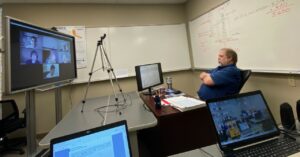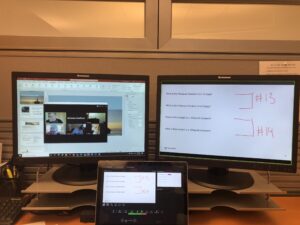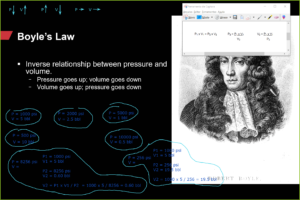Training providers seek new ways to teach, engage with students as well control training moves virtual
Companies look to smaller class sizes, pre-course system checks and mock teaching sessions to ensure effective delivery of training content
By Jay Stracke, Editorial Coordinator
When the World Health Organization (WHO) declared COVID-19 a global pandemic on 11 March, it set into motion a chain of reactions that, in effect, shut down all travel and most types of in-person congregations, including classrooms. It seemed like well control training and certification – normally a well-oiled machine that works behind the scenes of day-to-day drilling operations – could be ground to a halt, potentially threatening the continuity of drilling projects around the world.

Fortunately, that didn’t happen. Within weeks of the COVID lockdowns, IADC had rolled out WellSharp Live, a remote and distance learning option providing an interactive environment, real-time monitoring capabilities and course assessment proctoring. “The success of WellSharp Live really does reflect the commitment of our training providers, who have invested in the safety and competence of each trainee that attends their course,” said Brooke Polk, IADC Senior Director of Accreditation Operations.
Once IADC – working with drilling contractors, operators and training providers – figured out how to move WellSharp online while maintaining the program’s quality and integrity, it was then up to individual organizations and instructors to figure out exactly how they would deliver their course content while ensuring students remain engaged. In essence, they had to make sure that each student leaves the course with the knowledge and skills they need to do their jobs on the rig, even if instructors must now teach through a computer screen and don’t get the same opportunities for in-person engagement and communication.

At Valaris, the greatest challenge has been dealing with the differences of teaching in a virtual environment, where students are clicking on mouses instead of getting to put their hand on a choke handle, for example. However, using cloud-based simulators for equipment like mud pumps, drilling brakes and choke manifolds have produced good results so far, said Eliot Doyle, Senior Training and Competency Manager. “We have online simulators that replicate the same simulators that we use in person. The controls – the look of it – is all on screen. While they don’t get to put their hands on it physically, everything is identical to what everyone has been using for the last 10-15 years.”
One change that Valaris has made with its WellSharp Live courses is capping the number of students per class at eight, rather than the program’s stated maximum of 10. This gives instructors more time with students to answer questions individually, Mr Doyle said.
To ensure that students get the most out of each class, Smith Mason & Co has been relying on what it calls WellSharp Live system checks, where instructors reach out to students individually the week before a class to ensure they are prepared to learn in a virtual environment. This includes familiarizing the student with the Zoom platform, the WellSharp Live dashboard and any simulators involved, as well as with how the class will be facilitated. “I joke with every student that the only thing my team cannot help with is bad internet,” Marcus Mason, CEO of Smith Mason & Co, said.

Training providers also had to give extra consideration to how students can communicate – with instructors and with each other – in a virtual learning environment. The “chat” and “raise a hand” functionalities within Zoom have come in handy, allowing students to easily ask questions when they need additional help and letting instructors check in with students individually. “We remind them that just because they’re at home or they’re working virtually doesn’t change the conversation,” Mr Mason said. “It doesn’t change the information that’s being exchanged. The only difference is you’re sitting at home and you can go get a soda out of your refrigerator.”
On the instructors’ side, the change in course delivery has been a learning curve, too. “If you put an instructor who’s been teaching well control for 35 years in a classroom environment on a computer screen, you have to anticipate a lot of challenges, such as the difference in tone, the difference in cadence and the difference in the flow of material,” Mr Mason said.
To prepare for virtual delivery of training content earlier this year, Wild Well Control had its instructors work together via mock virtual classrooms to gain a better understanding of what worked and what didn’t in a virtual setting. As instructors went through their course materials, their peers “threw every problem that we could think of at them – such as bad connections or somebody not understanding – so that we can make it as seamless as possible when the students come to class,” Ken Smith, Vice President of Training for Wild Well Control, said.
One result from these mock sessions is that Wild Well decided to add a second instructor to each of its WellSharp Live classes to provide students the extra support and attention they might need in a virtual classroom. “In a virtual classroom, we found that if one person gets held up, it can affect the whole class a lot more than it would in person,” Mr Smith said. If there is a need for a student to “back up a little bit,” having a second instructor present has proven helpful in minimizing disruptions for other students as they can use Zoom’s “breakout room” functionality to give one-on-one assistance.
Future of virtual-based well control training
While the COVID-19 pandemic has thrown a wrench into just about everything this year, so far the drilling industry has been responding nimbly on the training front to ensure there are no operational disruptions. In fact, some companies are starting to look at lessons that could be learned and applied from what happened this year to enhance well control training for the future.
Valaris, for example, is looking at developing an app that could provide a “collaborative space” for the company’s well control training instructors to continue communicating with students on best practices, even after they leave a class and from anywhere in the world. It could also facilitate communication between employees and the company’s well control training team, providing access to subject matter experts and operations management personnel if guidance is needed related to well control, Mr Doyle said.
Additionally, the company is taking a new look at the efficacy of online training delivery in conjunction with potential cost savings. “It’s a much more cost-effective approach, not only from a delivery standpoint but also for the students,” Mr Doyle said. From May to September this year, virtual training options allowed Valaris to deliver well control training to 170 personnel located in 17 countries; that compares with 135 in the same time period in 2019. “We wouldn’t have been able to do this before without hiring more instructors, buying more simulators and setting up more classrooms.”
How virtual well control training will evolve in the future is still uncertain – as many things are in this post-COVID world – but whether it’s online or in person, Mr Mason said he believes a well control course must always be led by an experienced instructor. “There’s a place where blended learning solutions make sense in the future, but I don’t think you can replace conversation between the students and the instructor completely with e-learning.” DC




